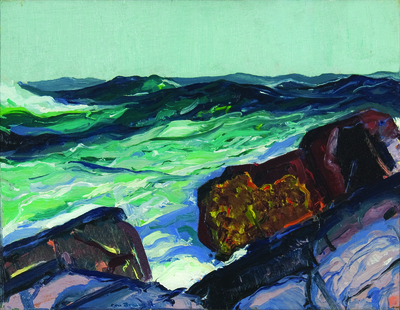Museum Directors Bring Out Maine’s Best
Above: George Bellows, Iron Coast, Monhegan, 1913, oil on board, 14 5/8 x 19″. Monhegan Museum of Art and History, gift of Jacqueline Hudson.
Spread across Portland Museum of Art’s first-floor galleries are more than 100 works of art—all carefully selected by directors of the eight institutions along the Maine Art Museum Trail (maineartmuseums.org), which also happen to be the state’s most important art-collecting museums. This exhibit “represents seemingly disparate viewpoints, entirely different eras and contrasting styles in the same room—side by side,“ says Mark Bessire, PMA director. “Some [directors] chose greatest hits and some chose stories.”
In this exhibit, Directors’ Cut, on view now through September 20, still lifes, portraits, landscapes and abstractions in a wide array of styles, perspectives and media by more than 56 artists give a broad sampling of Maine art. Three artists selected for this exhibit are native to Maine: Dozier Bell, Melonie Bennett and Marsden Hartley. The rest have sojourned, summered, immigrated or permanently settled here. Many of the artists, says Bessire, are also included in the newly reopened Whitney Museum of American Art’s America Is Hard to See, which runs concurrently with this exhibit through September.
Winslow Homer’s profound connection to Prouts Neck is told through the 35 objects selected by Anne and Frank Goodyear, co-directors of Bowdoin College Museum of Art. Among them are photographs, letters, architectural plans for his home and studio, paintbox, canteen, fishing net, knapsack, drawing mannequins, drawings, works on paper and etchings. A highlight is Homer’s iconic Eight Bells, an etching depicting two sailors determining their boat’s position with an octant. This portion of the exhibit proves a perfect introduction to visiting PMA’s Homer Studio.
Another intriguing story emerges from artworks and artifacts borrowed from the Marsden Hartley Memorial Collection at Bates College Museum of Art, in Lewiston. Works chosen by Bates director Dan Mills reinforce ties between Hartley and his hometown of Lewiston, while introducing viewers to Hartley’s circle: Berenice Abbott, Peggy Bacon, Chenoweth Hall, George Platt Lynes, John Marin, Carl Sprinchorn, Mark Tobey and Marguerite and William Zorach. Mills’s choices also give a generous nod to contemporary art with works by Robert Feintuch, Robert Neuman and Lewiston-born Dozier Bell with her delicate, moody charcoal drawings.
John Marin, From Seeing Cape Split, 1935, oil on canvas, 23 x 29½”. Colby College Museum of Art, gift of John Marin, Jr. and Norma B. Marin.
How many ways can an artist look at the Maine landscape? Colby director Sharon Corwin shows viewers with varied selections, tracing the evolution of Maine modernism, from an early 20th-century George Bellows painting of Monhegan’s monolithic Blackhead, to John Marin’s constructed modernist Maine coast, to paintings by postwar artists that include Lois Dodd, Rackstraw Downes, Richard Estes, Yvonne Jacquette and Alex Katz.
Farnsworth Art Museum director Christopher Brownawell’s contribution of works by all three generations of Wyeths—N.C., Andrew and Jamie—sets firmly Maine’s place in American art. N.C.’s Bright and Fair—Eight Bells, a painting made in honor of Homer’s etching Eight Bells, connects art, artists and institutions that are part of the museum trail. A lovely freestanding sculpture by Louise Nevelson, also from the Farnsworth, graces the gallery, as do works by Robert Indiana and Alex Katz.
The exhibit’s oldest painting, Aaron Draper’s On the Maine Coast (1858), tells the story of Maine’s oldest art colony: Monhegan Island. Ed Deci, director of the Monhegan Museum of Art and History, chooses Draper, the first artist to visit the far-flung island, who would end up leading endless waves of artists there. Evolving artistic movements can be tied to Monhegan, from Draper to the American impressionists; from Robert Henri, George Bellows and Rockwell Kent to the World War II-era modernists Louise Nevelson and John Hultberg, who arrived along with representational painter James Fitzgerald and others.
Charles H. Woodbury, who arrived in Ogunquit in 1896 and opened the first summer art school in America in 1898, was the first of Maine’s modernists. Hamilton Easter Field arrived in 1902 with his protégé Robert Laurent, establishing a rival art school in Ogunquit’s Perkins Cove. The school attracted Peggy Bacon, Marsden Hartley, Walt Kuhn, Yasuo Kuniyoshi, Gaston Lachaise, John Laurent and many others. Director Ronald Crusan tells this story through key offerings from the Ogunquit Museum of American Art’s collections, including a painting by Henry Strater who, in 1953, built the museum.
Bessire’s contributions from PMA all come from its well-known contemporary biennial, which it has hosted since 1998. “We want folks to support living, contemporary artists, so we buy a lot of contemporary art out of our biennial,” Bessire explains, choosing among these works by Lauren Fensterstock, John Bisbee, David Stess, Scott Peterman, Elke Morris, Melonie Bennett and Paul D’Amato. “It sets up and creates a nice invitation for the fall’s upcoming biennial, You Can’t Get There From Here.” A highlight among the PMA’s selections is a new mixed-media wall piece, Grotto, by Fensterstock.
Berenice Abbott, Columbus Circle, 1936, gelatin silver print, 13 x 10½”. On loan from the University of Maine Museum of Art. Museum Purchase: Stebbins and Schildknecht Art Fund.
Flanking the main entry of the gallery are a baker’s dozen of photographs from two primary bodies of work by Berenice Abbott, supplied by George Kinghorn, director of the University of Maine Museum of Art. They include seven of her New York pictures and six from her 1950s Portrait of Maine series.
This blockbuster summer exhibit at PMA is designed to motivate visitors to pick up a Maine Art Museum Trail map and explore Maine’s most important collecting museums, investigate their thousands of artworks and experience Maine’s fascinating art history.
Andres Azucena Verzosa is co-editor of the forthcoming Art in Maine: Contemporary Perspectives (University of Maine Press, 2015).



